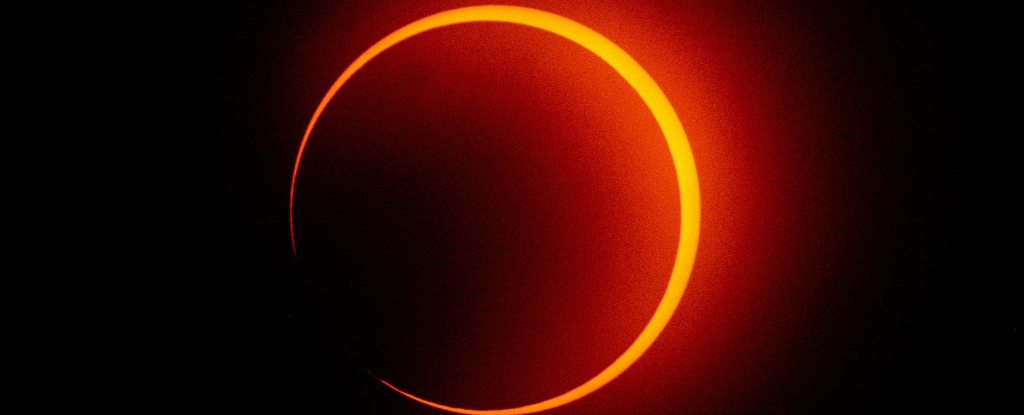The final eclipse of the year is almost upon us. If skies are clear, a few lucky observers and intrepid eclipse-chasers will get to witness the passage of the Moon in front of the Sun one last time on Wednesday, October 2nd during an annular solar eclipse.
The eclipse is the final one of the current season, and the last solar eclipse for 2024. The first – the April 8th total solar eclipse spanning North America – was witnessed by millions. This week’s eclipse is by contrast much more bashful.
Why Do Annulars Occur?
An annular solar eclipse occurs when the Moon is visually too small to cover the Sun. Both vary in apparent size throughout the month and year, as the orbits of the Moon and the Earth are both elliptical.
The shadow of the Moon falls short of the surface of the Earth during an annular eclipse, and the ‘ring of fire’ path is known as an antumbra.

We often marvel at how ‘perfect’ total solar eclipses are, but this situation is slowly changing.
Going forward, annulars are already more common, as the Moon slowly moves away from the Earth… in about 600 million years annulars will win this battle for good, as total solar eclipses will cease to occur on the surface of the Earth.

There’s good reason why this eclipse is annular. The Moon reaches its most distant apogee of 2024 on October 2nd at 50 minutes after eclipse conjunction at 19:08 Universal Time, at 406,516 kilometers from Earth.
Eclipse Path and Circumstances
The path crosses the South Pacific, and only makes landfall across Easter Island, Chile, Argentina. Maximum annularity reaches 7 minutes and 25 seconds in duration northwest of Easter Island.
There’s a chance for some excellent ‘horns of the Sun’ shots towards sunset around to Falkland Islands and the Horn of South America.

The partial phases of the eclipse will be visible from Antarctica and northern New Zealand, across southern South America all the way up to Brazil, Paraguay and Peru, up to a small sliver of the west Pacific coast of Mexico.
The Falkland Islands in the Atlantic ocean will see a narrow miss, with Stanley seeing an 84% obscured partial eclipse.
This eclipse also marks the end of the second and final eclipse season for 2024. This season was book-ended by the slight partial lunar eclipse earlier this month.
This eclipse is also member 17 in the 70 eclipses in relatively new Solar Saros Series 144. This saros is a prolific producer of annulars, and started on April 11th, 1736 and will end on May 5th 2980.
Viewing and Safety
Unlike a total solar eclipse, proper safety precautions must be taken during Wednesday’s eclipse… even during the annular phase.
A few percent of the Sun is still pretty bright, enough to give the sky a deep blue-steely tint, the only hint that something might be afoot. NASA has a pretty solid eclipse safety page.
There’s another low tech way to observe the eclipse. Keep an eye out for tiny crescent suns cast though natural pin hole projectors. These can include gaps in tree leaves and latticework. Kitchen utensils such as graters and strainers will also do the trick.

Comet T-ATLAS ‘may’ also make an appearance during the eclipse. Have any comets ever appeared during an annular? Certainly bright comets have made themselves known during the daytime.
There’s now a chance that Comet Tsuchinshan-ATLAS ‘may’ reach negative magnitudes in early October, and the comet will be ~20 degrees from the Sun during next Wednesday’s annular eclipse…
To be sure, it’s an extremely remote chance to see comet T-ATLAS against a bright sky, but I remember noticing Venus becoming plainly visible on April 8th about 10 minutes prior to totality, so you just never know…
The next eclipses in 2025 includes only two partial solars worldwide: one on March 29th for the North Atlantic, and another on September 21st for New Zealand and the South Pacific. The next annular won’t occur until February 17th, 2026 for the remote Antarctic.
Will the eclipse be carried live? As of writing this, no live streams along the path have emerged, but we’ll drop them here if any turn up.
If you have the chance, don’t miss this final eclipse of the year.
This article was originally published by Universe Today. Read the original article.





